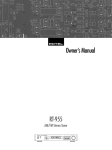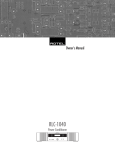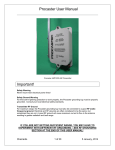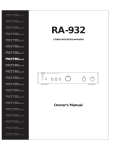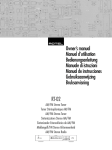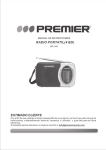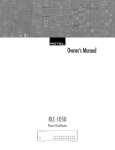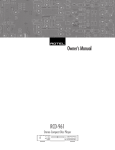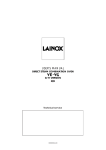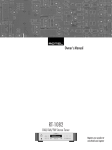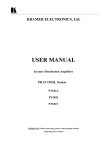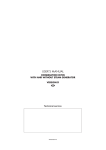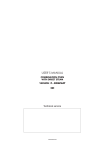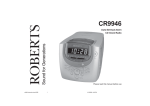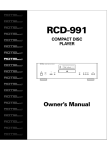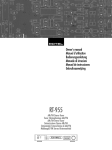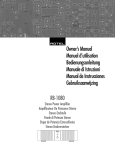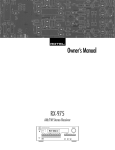Download Rotel RT-1080 User's Manual
Transcript
Owner’s Manual RT-1080 AM/FM Stereo Tuner AM/FM STEREO TUNER RT-1080 POWER PTY TA TP 1 2 3 4 ANT ATT DISPLAY AF 6 7 8 9 0 ANT A/B FM IF NARROW FM MONO MEMORY AUTO TUNING TUNE /PRESET PRESET SCAN BAND DOWN UP 5 RT-1080 AM/FM Stereo Tuner Cautions 2 WARNING: There are no user serviceable parts inside. Refer all servicing to qualified service personnel. WARNING: To reduce the risk of fire or electric shock, do not expose the unit to moisture or water. Do not allow foreign objects to get into the enclosure. If the unit is exposed to moisture, or a foreign object gets into the enclosure, immediately disconnect the power cord from the wall. Take the unit to a qualified service person for inspection and necessary repairs. Read all the instructions before connecting or operating the component. Keep this manual so you can refer to these safety instructions. Heed all warnings and safety information in these instructions and on the product itself. Follow all operating instructions. Clean the enclosure only with a dry cloth or a vacuum cleaner. You must allow 10 cm or 4 inches of unobstructed clearance around the unit. Do not place the unit on a bed, sofa, rug, or similar surface that could block the ventilation slots. If the component is placed in a bookcase or cabinet, there must be ventilation of the cabinet to allow proper cooling. Keep the component away from radiators, heat registers, stoves, or any other appliance that produces heat. The unit must be connected to a power supply only of the type and voltage specified on the rear panel of the unit. Connect the component to the power outlet only with the supplied power supply cable or an exact equivalent. Do not modify the supplied cable in any way. Do not attempt to defeat grounding and/or polarization provisions. Do not use extension cords. Do not route the power cord where it will be crushed, pinched, bent at severe angles, exposed to heat, or damaged in any way. The power cord should be unplugged from the wall outlet if the unit is to be left unused for a long period of time. Immediately stop using the component and have it inspected and/or serviced by a qualified service agency if: • The power supply cord or plug has been damaged. • Objects have fallen or liquid has been spilled into the unit. • The unit has been exposed to rain. • The unit shows signs of improper operation • The unit has been dropped or damaged in any way Place the unit on a fixed, level surface strong enough to support its weight. Do not place it on a moveable cart that could tip over. NOTE TO CATV SYSTEM INSTALLER: Call the CATV system or antenna installer’s attention to Article 820-40 of the NEC. This provides guidelines for proper grounding and, in particular, specifies that the cable ground shall be connected to the grounding system of the building, as close to the pint of cable entry as practical. See installation diagram. NOTE: This equipment has been tested and found to comply with the limits for a Class B digital device, pursuant to Part 15 of the FCC Rules. These limits are designed to provide reasonable protection against interference in a residential installation. This equipment generates and can radiate radio frequency energy and, if not installed and used in accordance with the instructions, may cause interference to radio or TV communications. There is no guarantee that interference will not occur in a particular installation. If this equipment does cause interference to radio or television reception, which can determined by turning the equipment off and on, try to correct the interference by one or more of the following measures: • Reorient or relocate the receiving antenna. • Increase the separation between the unit and the television tuner. • Connect the unit to an AC power outlet on a different electrical circuit. • Consult your authorized Rotel retailer for assistance. English 3 1: Controls and Connections 1 2 3 4 5 6 7 AM/FM STEREO TUNER RT-1080 POWER 8 9 TP 1 DISPLAY AF 6 7 FM IF NARROW FM MONO MEMORY AUTO TUNING PTY TA ANT ATT ANT A/B 10 11 DOWN 12 13 UP 14 15 12V TRIGGER AM/FM STEREO TUNER MODEL NO. RT-1080 POWER CONSUMPTION: 10 W ANTENNA 3 4 5 8 9 0 TUNE /PRESET PRESET SCAN BAND 16 17 18 19 COMPUTER I/O OUT WARNING: SHOCK HAZARD – DO NOT OPEN AVIS: RISQUE DE CHOC ELECTRIQUE–NE PAS OUVRIR OUTPUTS FM A IN 2 B AM G RT-1080 LEFT EXT REM. RIGHT IN 20 21 22 23 24 25 26 2: Hook-up Illustration 12V TRIGGER AM/FM STEREO TUNER MODEL NO. RT-1080 POWER CONSUMPTION: 10 W ANTENNA B AM G RT-1080 COMPUTER I/O OUT WARNING: SHOCK HAZARD – DO NOT OPEN AVIS: RISQUE DE CHOC ELECTRIQUE–NE PAS OUVRIR OUTPUTS FM A IN LEFT EXT REM. RIGHT IN RT-1080 AM/FM Stereo Tuner 4 3: RR-T92 Remote Control 1 2 3 4 5 6 FM IF NARROW 7 8 9 FM MONO DIMMER I J A K 0 L ANT AB ANT ATT AUTO TUNING PRESET SCAN TUNE /PRESET B M FREQUENCY MEMORY DIRECT C N D DISPLAY O E PTY AF TP TA F P Q G BAND < TUN/PRESET > H R RR-T92 English 5 Contents About Rotel Boxed numbers refer to RT-1080 illustration. Boxed letters refer to RR-T92 illustration. A family whose passionate interest in music led them to manufacture high fidelity components of uncompromising quality founded Rotel over 40 years ago. Through the years that passion has remained undiminished and the family goal of providing exceptional value for audiophiles and music lovers regardless of their budget, is shared by all Rotel employees. 1: Controls and Connections 3 Basic Tuning Controls .............................. 8 2: Hook-up Illustration 3 BAND Button 8 3: RR-T92 Remote Control 4 TUNING Controls 8 About Rotel ........................................... 5 NUMERIC Buttons: Station Presets 8 Getting Started ...................................... 5 Key Features 6 FREQUENCY DIRECT Button: Direct Access Tuning 9 Unpacking 6 AUTO TUNING Button 9 Placement 6 TUNE/PRESET Button 9 Cables 6 PRESET SCAN Button 9 Remote Control ...................................... 6 RDS and RBDS Reception ........................ 9 Remote Sensor 6 DISPLAY Button 9 Remote Control Batteries 6 PTY Button 10 Rear Panel Connections .......................... 6 TP Button 10 RCA Outputs 6 TA Button 10 AM Loop Antenna 6 AF Button 10 FM Antenna 7 Additional Tuning Features .................... 10 AC Input 7 FM MONO Button 10 12V TRIGGER Connections 7 ANT ATT Button 10 EXT REM. IN Jack 7 FM IF NARROW Button 10 COMPUTER I/O Interface 7 ANT A/B Button 10 Basic Operating Controls ......................... 7 Specifications ....................................... 11 Power Button 7 FM Tuner 11 Front Panel Display 7 AM Tuner 11 DIMMER Button 7 General 11 MEMORY Button 7 Setting Country Mode 8 The engineers work as a close team, listening to, and fine tuning each new product until it reaches their exacting musical standards. They are free to choose components from around the world in order to make that product the best they can. You are likely to find capacitors from the United Kingdom and Germany, semi conductors from Japan or the United States, while toroidal power transformers are manufactured in Rotel’s own factory. Rotel’s reputation for excellence has been earned through hundreds of good reviews and awards from the most respected reviewers in the industry, who listen to music every day. Their comments keep the company true to its goal – the pursuit of equipment that is musical, reliable and affordable. All of us at Rotel, thank you for buying this product and hope it will bring you many hours of enjoyment. Getting Started Thank you for purchasing the Rotel RT-1080 AM/FM Stereo Tuner. When used in a highquality music audio system, it will provide years of musical enjoyment. The RT-1080 is a full featured, high performance component. All aspects of the design have been optimized to retain the full dynamic range and subtle nuances of your music. Rotel’s Balanced Design Concept combines advanced circuit board layout, comprehensive parts evaluation, and extensive listening tests for superior sound and long term reliability. The printed circuits are designed with Symmetrical Circuit Traces so that the precise timing of the music is faithfully preserved. Metal film resistors and polystyrene or polypropylene capacitors are used in important signal paths. All aspects of this design have been examined to ensure the most faithful music reproduction. RT-1080 AM/FM Stereo Tuner The main functions of the RT-1080 are easy to install and use. If you have experience with other stereo systems, you shouldn’t find anything perplexing. Simply plug in the associated components and enjoy. Key Features • Full-function wireless remote control • User-friendly Fluorescent Display • AM and FM tuning capabilities • 30 Station Presets for memorizing your favorite stations • Manual frequency and preset tuning, autosearch tuning, preset scanning, and frequency direct tuning. • RDS (Radio Data System) capability for Europe and RBDS (Radio Broadcast Data Service) capability for the USA. • Dual selectable FM antenna inputs • Stereo/mono switching, selectable local/ distance antenna attenuation, selectable narrow/wide IF band. • 12 volt trigger connections for remote turn on/off by Rotel preamplifiers and surround processors. • Computer I/O connection for operation of the unit from a home automation controller or a computer running special software Unpacking Carefully remove the RT-1080, the remote control, and accessories from the shipping carton. Save the shipping carton and all enclosed packing material for future use. Shipping or moving the unit in anything other than the original packing material may result in severe damage. Keep the original sales receipt. It is your best record of the date of purchase, in the event warranty service is ever required. Placement Like all audio components that handle low-level signals, the RT-1080 can be affected by its environment. Avoid placing the RT-1080 on top of other components. 6 The RT-1080 generates some heat as part of its normal operation. There should be 10 cm (4 inches) of clearance around the chassis, and reasonable airflow through the installation location, to prevent overheating. Place the unit on a solid shelf. We recommend installing the RT-1080 in furniture designed to house audio components. Such furniture is designed to reduce or suppress vibration which can adversely affect sound quality. Ask your authorized Rotel dealer about component furniture and proper installation. The RT-1080 is supplied with an RR-T92 remote control and must be placed where the infrared signal from the remote can reach the front panel Remote Sensor. Remote Control Batteries Two UM-4/AAA size batteries (supplied) must be installed before the remote control can be used. To install the batteries, remove the cover on the back of the RR-AT92. Install the batteries as shown in the illustration in the battery well. Test the control for proper operation, then replace the cover. When the batteries become weak the remote control won’t operate the RT-1080 consistently. Installing fresh batteries should eliminate the problem. NOTE: Remove the batteries from the remote if it will not be used for a long period of time. Do not leave run down batteries in the remote control; they can leak corrosive chemicals which will damage the unit. Cables Keep power cords, digital cables, and audio cables away from each other. This will minimize the chance of the audio signal cables picking up noise or interference from the power cords or digital cables. Using high quality, shielded cables will also help to prevent noise or interference. If you have any questions see your authorized Rotel dealer for advice about the best cable to use with your system. Remote Control The RT-1080 includes an RR-T92 remote control that operates many of the features of the RT-1080. Remote Sensor The remote sensor receives infrared signals from the remote control. Do not cover or block the sensor. It must be unobstructed or the remote control will not work properly. The operation of the remote sensor can also be affected if exposed to bright sunlight or certain types of lighting (such as halogen lights) that emit infrared light. In addition remote control functions may not work reliably if the batteries in the RR-AT92 are weak. NOTE: To use the remote, aim it at the remote sensor on the front panel of the RT-1080. Rear Panel Connections The RT-1080 provides rear panel connections for audio line level output, two FM antennas, an AM antenna, computer interface, a remote IR connection, 12V trigger connections for remote turn-on and AC power input. NOTE: Do not plug any system component into an AC source until system hookup is complete and you are sure that all connections have been properly made. RCA Outputs A pair of line level RCA audio outputs sends a fixed-level stereo signal from the RT-1080 to your preamplifier, surround processor, or integrated amplifier. Use a standard RCA audio cable to connect the left output jack to the left channel tuner input on your system controller and the right output jack to the right channel tuner input on your system controller. AM Loop Antenna The RT-1080 includes a loop antenna to receive AM radio signals. Remove this antenna from the box and locate it near the RT-1080. Connect the 300 ohm twin-conductor wire from the loop antenna to the pair of screw terminals labeled AM LOOP, attaching one wire to each terminal. It does not matter which wire attaches to which terminal, but make sure that the connections are solid and that the two wires do not touch. English 7 You may need to rotate or otherwise reorient the antenna to find the best position. NOTE: To use an outdoor antenna, connect its 300 ohm twin-conductor wire instead of the loop antenna, only after a professional contractor has installed the antenna system in accordance with local electrical codes. FM Antenna The RT-1080 has two FM antenna connections, labeled A and B. This permits you to switch between two different FM antenna systems using a front panel or remote control switch. This feature could be useful to switch between an indoor antenna and an outdoor antenna system or between a standard FM antenna and a cable or satellite TV decoder that provides an FM antenna signal. NOTE: The following instructions assume the use of a standard FM wire antenna supplied with the unit. To hook up a cable or satellite TV FM antenna system, see the instructions supplied with that unit. The RT-1080 is supplied with a T-shaped indoor FM antenna. Connect the attached coax F-type plug to one of the FM antenna connectors on the RT-1080. For best reception, unfold the T-shaped antenna. Eyelets at both ends of the T allow tacking the antenna to a wall, if desired. Experiment with positioning for best reception. NOTE: To use an outdoor antenna, connect its 75 ohm coax lead wire to the FM connector instead of the indoor wire antenna, only after a professional contractor has installed the antenna system in accordance with local electrical codes. In the USA, you will need to use the supplied F-type converter to connect the 75 ohm coax cable to the antenna input. AC Input Your RT-1080 is configured at the factory for the proper AC line voltage in the country where you purchased it (115 volts/60Hz in the USA and 230 volts/50Hz in Europe). The AC line configuration is noted on a decal on the back of your unit. Make sure that your unit is configured properly for your AC voltage. Plug the supplied cord into the AC input receptacle on the back of the unit. Once all other rear panel connections are completed, plug the power cord into an AC wall outlet or switched AC outlet on another component. 12V TRIGGER Connections The RT-1080 can be activated by a 12 volt trigger signal from a Rotel preamplifier. These two connections provide an input to receive the 12 volt trigger signal from the preamp and an output to pass through the trigger signal to another component such as a Rotel power amplifier. The trigger input accepts any control signal (AC or DC) ranging from 3 volts to 30 volts. When a cable is connected to the input and a trigger signal is present, the tuner is activated. When the trigger signal is interrupted, the tuner goes into standby mode. The front panel indicator light remains lit, but the display goes dark and the unit will not operate. NOTE: When using the 12V Trigger feature, leave the POWER button in the ON position. EXT REM. IN Jack This 3.5mm jack receives command codes from industry-standard infrared receivers (Xantech, etc.) via hard-wired connections. This feature could prove useful when the unit is installed in a cabinet and the front panel sensor is blocked. Consult your authorized Rotel dealer for information on external repeaters and the wiring of a jack to fit the receptacle. Basic Operating Controls The following explanations will help you get familiar with the features and controls. When a function is available on both the front panel and the remote, a number (see front panel illustration) and a letter (see remote control illustration) are shown in the instructions. For example, to change from the AM to FM band, you can either press the front panel button or use the button on the remote. When only one identifier appears, that control is available only on the front panel or the remote, but not both. Power Button The POWER button is located on the front panel of the RT-1080 and is not duplicated on the remote control. Push the button in to turn the unit on. The LED above the switch and the display will light up. Push the button again (returning it to the out position), to turn the unit off. NOTE: If you are using a switched outlet on another component to power the RT-1080 or if you are using the 12 volt trigger feature, leave the POWER switch in the ON position. Front Panel Display The fluorescent display in the center of the RT-1080 provides status information used in operating the AM/FM receiver (such as station frequency display, band, preset memory, RDS information, etc.). COMPUTER I/O Interface DIMMER Button The unit can be operated from a home automation controller or a computer running audio system control software from third-party developers. This control is accomplished by sending the operating codes normally sent by the RR-T92 remote over a hard-wired network connection from the computer. Available only on the remote control, this button selects three display brightness settings: NORMAL, DIM, or OFF. When the display is OFF, pressing any button or control will return it to the NORMAL mode. Press the button to cycle through the three settings. The COMPUTER I/O input provides the necessary connection on the back panel. It accepts standard RJ-45 8-pin modular plugs, such as those commonly used in 10-BaseT UTP Ethernet cabling. For information on the connections, software, and operating codes for computer control, contact your authorized Rotel dealer. NOTE: When the tuner is turned off and back on, the display reverts to its normal setting. MEMORY Button The MEMORY button is used to confirm and memorize various settings in the setup and operation of the RT-1080, including tuner station presets. Its use is described in detail in the relevant sections that follow. RT-1080 AM/FM Stereo Tuner Setting Country Mode The RT-1080 has two modes (one for the USA and one for Europe) that configure the unit for differences in local markets, including FM tuning intervals, AM tuning intervals, and differences in the European RDS and United States RBDS standards. Your unit has been factory configured to the correct mode for the country in which it was purchased. To switch to the USA mode, press and hold the POWER, MEMORY, and 9 buttons for 5 seconds. The word LOADING will appear in the display and the unit will power up in the USA configuration. To switch to the European mode, press and hold the POWER, MEMORY, and 0 buttons for more than 5 seconds. The word LOADING will appear in the display and the unit will power up in the European configuration. Basic Tuning Controls The RT-1080 features a digital synthesized AM/ FM tuner with RDS or RBDS capability and 30 station presets. The unit offers a wide range of tuning options. Here is an overview of the tuning options (more detailed information is provided in subsequent sections of this manual): • Manual frequency tuning tunes up or down to the next station frequency. Set the TUNE/PRESET mode to TUNE. Turn off AUTO TUNING. Use the DOWN/UP controls to tune up or down. • Direct frequency tuning lets you enter the desired station frequency digits. Press the FREQUENCY DIRECT button on the remote and enter the digits using the NUMERIC buttons. • Automatic frequency search tuning lets you search up or down to find the next receivable broadcast signal. Set the TUNE/ PRESET mode to TUNE. Turn on AUTO TUNING. Use the DOWN/UP controls to search up or down. • Memory station preset tuning lets you directly enter the number of a memorized station preset number. Enter the number of the memorized preset using the NUMERIC buttons. 8 • Preset scan tuning scans through the memorized station presets. Press the PRESET SCAN button to begin scanning. • RDS (Europe) or RBDS (USA) tuning provides special tuning and search features based on data codes encoded with the broadcast signal. See the RDS section of this manual for detailed information. BAND Button The BAND button selects whether the tuner receives AM or FM broadcast signals. Press the button to toggle between AM and FM. An indicator will light at the left portion of the display to confirm your choice. The currently tuned station frequency will be shown. TUNING Controls A pair of buttons, labeled DOWN/UP on the front panel and < TUN/PRESET > on the remote, serve as the main tuning controls for the RT-1080. In the following instructions, we refer to these as DOWN/UP buttons. You can use either the front panel or remote buttons; their function is identical. These controls provides different tuning functions, depending on the mode of operation: In the FREQUENCY TUNING mode with AUTO TUNING off, press a DOWN/UP button to manually jump to the next frequency, regardless of whether or not a station is broadcasting on that frequency. See the TUNE/PRESET button and AUTO TUNING button sections for details on changing the tuning modes. In the FREQUENCY TUNING mode with AUTO TUNING on, press a DOWN/UP button to start auto tuning. The tuner begins automatically scanning up or down through the frequencies until the next receivable signal is detected. If this is not the desired station, repeat the automatic tuning procedure to find the next station. Weak stations will be skipped during auto tuning. If no receivable signal is detected, the tuner will revert to the last previously tuned station. See the TUNE/ PRESET button and AUTO TUNING button sections for details on changing the tuning modes. In the PRESET TUNING mode, press a DOWN/UP button to advance to the next memorized station preset. See the TUNE/PRESET button section for details on changing the tuning modes. In the RDS PTY search mode, press a DOWN/UP button to select the desired program type from the scrolling list in the display. See the RDS PTY button in the section on RDS tuning for details. NOTE: Several indicators in the display assist tuning. A large display shows the tuned frequency. A signal strength indicator shows the strength of the incoming signal. A TUNED indicator lights when a sufficiently strong signal is received. A ST indicator lights when a stereo FM signal is received. Indicators show the currently selected tuning mode. NUMERIC Buttons: Station Presets The RT-1080 can store up to 30 station presets for recall using the NUMERIC keypad. These station presets can be used for any combination of AM stations and FM stations. The RT-1080 is delivered from the factory with a set of generic station presets that may or may not match available stations in your area. To memorize a new station preset: 1. Tune to the desired station, AM or FM. 2. Press the MEMORY button. A MEMORY indicator will flash in the display. 3. While the MEMORY indicator is flashing, press the number of the preset where you wish to store the station frequency. For example, to memorize preset 3, press the 3 button. To memorize preset 15, press the 1 button followed by the 5 button. 4. A previously stored frequency is erased from memory when a new frequency is memorized for the same preset. To tune to a previously memorized station preset, press the preset number using the NUMERIC buttons. For example, to tune to preset 3, press the 3 button. To tune to preset 30, press the 3 button and then press the 0 button within 5 seconds. NOTE: The NUMERIC buttons can also be used for FREQUENCY DIRECT tuning. English 9 FREQUENCY DIRECT Button: Direct Access Tuning If you know the frequency of the desired station, you may tune it directly using the FREQUENCY DIRECT button (remote only) and the NUMERIC buttons. 1. Press the FREQUENCY DIRECT button to change the NUMERIC buttons from station preset to direct access mode. The display will change to a series of bars, representing the digits of a station frequency, with the first bar blinking. 2. Enter the first digit of the station frequency using the NUMERIC buttons. The digit will appear in the frequency display and the next bar will flash. Enter the remaining digits of the frequency. When all of the digits have been entered, the tuner will automatically tune to the displayed station frequency. NOTE: On the USA version only, pressing 1 in the FM mode will enter 10 as the digit in the frequency display. On the European version, press 1 and then 0 to enter 10. For US FM stations, press only one digit following the decimal point as shown in the first example following. For European FM stations, press two digits after the decimal point as shown in the second example. EXAMPLES: (USA FM) 87.50MHz (Europe FM) 87.50MHz (all AM) 1610kHz Press 8>7>5 Press 8>7>5>0 Press 1>6>1>0 If no frequency is entered within 5 seconds, the tuner will cancel FREQUENCY DIRECT tuning mode and revert to the last previously tuned station. AUTO TUNING Button The AUTO TUNING button toggles between the frequency search tuning feature and manual frequency tuning. When using the DOWN/ UP buttons in AUTO TUNING mode, the tuner will begin automatically scanning up or down through the frequencies until the next receivable signal is detected. If this is not the desired station, use the DOWN/UP buttons again to find the next station. Weak stations will be skipped during auto tuning. If no receivable signal is detected, the tuner will revert to the previously tuned station. To toggle between FREQUENCY TUNING mode and AUTO TUNING mode, press the AUTO TUNING button. An AUTO indicator will appear in the display. NOTE: AUTO TUNING mode is disengaged when the TUNE/PRESET button is set to PRESET tuning mode. See the following section. TUNE/PRESET Button The TUNE/PRESET button toggles between FREQUENCY TUNING mode (the DOWN/ UP buttons advance to the next station frequency) and PRESET TUNING mode (the DOWN/UP buttons advance to the next station preset). To toggle between the two modes, press the TUNE/PRESET button. A PRESET indicator in the display will light when the PRESET mode is active. NOTE: AUTO TUNING mode is disengaged when the TUNE/PRESET button is set to PRESET tuning mode. PRESET SCAN Button This button activates a preset scanning feature. When you press the button, the tuner will automatically scan through all memorized station presets, playing each for five seconds before moving to the next. To stop the station scanning when the desired station preset is reached, press the button again. NOTE: If a PRESET station is currently tuned when the PRESET SCAN button is pressed, scanning will start with the next higher preset number and continue through all presets, stopping on the initial preset. If a PRESET station is not currently tuned when the button is pressed, scanning will start from PRESET 1 and continue to PRESET 30. 1. a display of the station’s identifying name (e.g. BBC1) 2. a display of the station’s program content (e.g. ROCK or NEWS) 3. traffic information broadcasts 4. a scrolling text display for announcements or information In addition, RDS provides several advanced search features including: 1. Search for a station with the desired program content (PTY) 2. Search for traffic information (TP) 3. Search for stations broadcasting special traffic announcements (TA). RDS broadcasting has been widely available in many European markets for years. There are a large number of RDS stations and most users will be familiar with the features and operation. In the USA, implementation of the RBDS system is more recent. Fewer stations are broadcasting RBDS signals and the features may be less familiar to many users. Ask your authorized Rotel dealer for information on RDS or RBDS broadcasting in your area. NOTE: The RDS and RBDS features are entirely dependent on the broadcaster sending properly encoded signals. Thus, they will only be available where RDS or RBDS is currently implemented and where stations are broadcasting these data signals. If there are no RDS or RBDS stations, the RT-1080 will function as a standard radio receiver. NOTE: RDS and RBDS services are only available on FM broadcasts. The features described are only operational in FM mode. DISPLAY Button RDS and RBDS Reception The Rotel RT-1080 is equipped with RDS (Radio Data Systems) capabilities for Europe and RBDS (Radio Broadcast Data Service) capabilities for the United States. These broadcast systems provide additional functionality to FM radio reception by transmitting encoded information along with the radio signal. This signal is decoded by an RDS or RBDS receiver and can provide a range of informational features including: There are five display options when the tuned station is broadcasting RDS data and the RDS indicator in the display is lit. Press the DISPLAY button to step through the five available options: 1. Standard FREQUENCY display. 2. PROGRAM SERVICE name. This is typically the station’s call letters, such as BBC1. If the current station is not broadcasting an RDS signal, the display will show a blinking PS indication. RT-1080 AM/FM Stereo Tuner 3. PROGRAM TYPE. This is a description of the station’s content from a list of program types (for example: NEWS, CURRENT AFFAIRS, INFO, SPORT, EDUCATION, DRAMA, CULTURE, SCIENCE, VARIED, POP, ROCK, EASY LISTENING, LIGHT CLASSICAL, SERIOUS CLASSICAL, OTHER MUSIC, WEATHER, FINANCE, CHILDREN, SOCIAL AFFAIRS, RELIGION, PHONE IN, TRAVEL, LEISURE, JAZZ, COUNTRY, NATIONAL MUSIC, OLDIES, FOLK, and DOCUMENTARY). If the station is not broadcasting an RDS signal, the display will show a blinking PT indication. 4. CLOCK TIME. A time and date display broadcast by the station. If the station is not broadcasting an RDS signal, the display will show a blinking CT indication. 5. RADIO TEXT. Scrolling text messages broadcast by the station. If the station is not broadcasting an RDS signal, the display will show a blinking RT indication. PTY Button The PTY search function scans for RDS stations broadcasting a particular type of program. 1. Press the PTY button. The current RDS program content type appears in the display. 2. If desired, change to a different PROGRAM TYPE using the DOWN/UP buttons to scroll through the list. 3. Press the PTY button a second time within 5 seconds. The tuner will attempt to find an RDS station broadcasting the selected type of program. If the button is not pressed within 5 seconds after selecting a program type, the PTY function will be cancelled. 4. If no station is located for the desired content type, the tuner will return to the last previously tuned station. 5. Cancel the PTY function by pressing any button (except DIMMER or FM MONO). TP Button Searches for an RDS station broadcasting traffic information programming: 1. Press the TP button. The tuner will attempt to find an RDS station broadcasting the traffic programming. 2. If no station is located, the tuner will return to the last previously tuned station. 3. Cancel the TP function by pressing any button (except DIMMER or FM MONO). 10 TA Button Searches for an RDS station broadcasting special traffic announcements: 1. Press the TA button. The tuner will attempt to find an RDS station broadcasting traffic announcements. 2. If no station is located, the tuner will return to the last previously tuned station. 3. Cancel the TA function by pressing any button (except DIMMER or FM MONO). AF Button In some cases, an RDS station is part of a network of stations broadcasting the same programming (for example, BBC1 programming in the UK may be available at several different frequencies). Stations broadcasting this programming may transmit an RDS data signal providing the tuner with a list of alternate frequencies where this programming is available. If this data list is transmitted, an AF indicator will appear in the display. The AF button is used to scan the alternate frequencies to find a stronger signal. The button is only functional when the AF indicator is lit. 1. Press the AF button. The tuner will scan each of the alternate frequencies for the same programming in the stored list and tune to the strongest signal. 2. If no station is located, the tuner will return to the last previously tuned station. 3. If the signal strength of the new station is weaker, the tuner will revert to the previously tuned station. 4. Cancel the AF function by pressing any button (except DIMMER or FM MONO). Additional Tuning Features The following buttons provide features which may be used to improve FM reception and/ or provide additional functionality: FM MONO Button The FM MONO button changes the FM mode from stereo reception to mono reception. In stereo mode, a stereo signal will be heard if the station is broadcasting a stereo signal and there is sufficient signal strength. A stereo in- dicator will light in the display. In mono mode, a mono signal will be heard even if the station is broadcasting a stereo signal. NOTE: Switching to mono mode can be a useful way to improve the reception of weak or distant FM signals. Less signal strength is required for clean mono reception than for stereo reception. ANT ATT Button Sometimes known as a LOCAL/DISTANCE switch, the ANT ATT button reduces the signal level at the FM antenna input. For the best reception of stations located some distance away, this button should be in the default or OFF position. However, if you are located in an urban area very close to the radio transmitter, the incoming signal may be high enough to overload the FM inputs. Press this button to reduce the incoming signal. When activated, a LOC indicator appears in the display. Press the button again to toggle back to normal operation. This switch only effects FM reception. FM IF NARROW Button FM reception works by receiving and decoding a carrier signal centered at the tuned frequency. To accommodate broadcast stations that may be misadjusted off this carrier frequency, the receiver accepts signals slightly to either side of the tuned frequency. This generally provides satisfactory performance. If you are located in an urban area with a large number of stations at closely spaced frequencies, you may occasionally notice interference from adjacent stations. To provide better performance under these conditions, the RT-1080 allows you to reduce the range of frequencies to either side of the precise tuned frequency, thus reducing inter-station interference. Press the FM IF NARROW button to use this feature. A NARROW indication will appear in the display. Press the button again to toggle back to normal operation. ANT A/B Button As described in the REAR PANEL CONNECTIONS section of this manual, the RT-1080 provides two FM antenna connections, labeled A and B. This button toggles between the two antenna inputs. An A or B indicator will appear in the display, indicating which FM antenna input is active. 11 Specifications FM Tuner Usable Sensitivity: 12.2 dBf 50dB Quieting Sensitivity: 20.2 dBf (mono) 45.3 dBf (stereo) Signal to Noise Ratio (at 65 dBf): 75 dBf (mono) 72 dBf (stereo) Harmonic Distortion (at 65 dBf): 0.2% (mono) 0.3% (stereo) Frequency Response: 10 Hz-15 kHz, ± 3 dB Capture Ratio: 2.0 dB Alternate Channel Selectivity: 47 dB (± 400 kHz) Spurious Response Ratio: 90 dB Image Rejection Ratio: 80 dB IF Rejection Ratio: 80 dB AM Suppression Ratio: 55 dB Stereo Separation (100Hz/1 kHz/10 kHz): 40 dB/45 dB/35 dB Output level: 1.2V Antenna Input: 75 ohms unbalanced AM Tuner Usable Sensitivity: 300 µV/m Selectivity: 25 dB Harmonic Distortion: 0.5% Image Rejection Ratio: 45 dB Signal to Noise Ratio: 48 dB Output level: 165 mV Antenna Input: Loop Antenna General Power Consumption: 10 watts Power Requirements (AC): 115 volts, 60 Hz (USA version) 230 volts, 50 Hz (European version) Weight: 4.7 Kg/10.4 lb. Dimensions (W x H x D): 430 x 92 x 340 mm 1615/16" x 35/8" x 137/16" All specifications are accurate at the time of printing. Rotel reserves the right to make improvements without notice. Rotel and the Rotel HiFi logo are registered trademarks of The Rotel Co, Ltd., Tokyo, Japan. English The Rotel Co. Ltd. 10-10 Shinsen-Cho Shibuya-Ku Tokyo 150-0045 Japan Phone: +81 3-5458-5325 Fax: +81 3-5458-5310 Rotel of America 54 Concord Street North Reading, MA 01864-2699 USA Phone: +1 978-664-3820 Fax: +1 978-664-4109 Rotel Europe Meadow Road Worthing, West Sussex BN11 2RX England Phone: +44 (0)1903 524 813 Fax: +44 (0)1903 524 831 Rotel Deutschland Kleine Heide 12 D-33790 Halle/Westf. Germany Phone: +49 05201-87170 Fax: +49 05201-73370 www.rotel.com 082 OM-RT-1080 ENGLISH 102700












